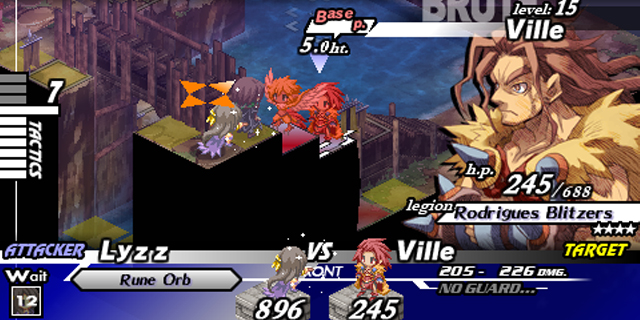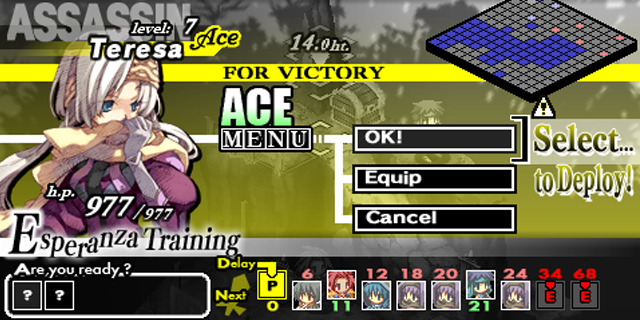
Gungnir, the latest in Atlus and Sting’s Dept. Heaven series, is supposed to be bizarre. It is, after all, Episode IX of a series that, while jumping and skipping around rather than releasing sequentially, is supposed to be further and further from normal the higher that episode number gets. It’s five installments crazier than Knights in the Nightmare, a game that put bullet-hell mechanics into a tactical RPG.
As it turns out, though, Gungnir is relatively traditional. It’s a strange choice, but one that results in a game that’s more accessible and still fun.
At first glance, it’s a very standard strategy RPG in the vein of Final Fantasy Tactics or Tactics Ogre. Actually, scratch that. That’s the second glance. The first glance is a disorienting, dizzying moment as you try to understand what the heck’s going on with that interface. This is a Dept. Heaven tradition, layering stats and information in a bunch of different forms and sizes wherever it’ll fit on the screen. A few hours in, it starts to click, but it may turn some off before that point. Some things could have been scaled back just a little, like making menu screens nice and linear or not having secondary information huge and watermarked, but it certainly makes everything look distinctive.

But back to the gameplay. Again, it looks like standard tactics, but it has just enough twists to make things interesting. How does it do it? Time. Gungnir doesn’t have standard turns; rather, a timeline includes all the enemies and whenever your next turn is. On your turn, you can move anyone who hasn’t moved too recently, and the more you do, the longer you wait until the next turn. Also, if you really need to, you can move units that aren’t ready to move again, but at the cost of a semi-permanent HP hit. These moves also include taking over parts of the map: certain squares can be claimed as bases to collect Tactics Points, used for special moves. Large gems and treasure chests must be broken open to gain the items inside, and this time could instead be used attacking the enemy, so it’s a tough balance. You only get to do so much.
Maximizing what you can do on your turn is a matter of formation. Attacks, even ranged ones, can generally only be made in cardinal directions. If you attack an enemy, and other units are in range and lined up to also hit them, you can use Tactics Points to “beat” and combo-attack. You can also have allies lined up with you “boost” your attack, reducing enemy guard chance, increasing power or whatever boost ability that ally has. If you spend a lot of points, you can do both, so finding good formations (and maintaining them throughout your advance) is tricky. What’s more, you need to stay away from the edges of things, because if an enemy pushes you off the side, your unit is lost for the map. (And your party’s generally tiny.)
Out of battle, the management is just as crazy. Sure, you can only use about six people in a map, but there are many, many more classes than that, and acquiring new units is fairly easy (either as free volunteers or hired mercenaries). There’s a lot to do, and you can basically drown in it. For those willing to stick it out and go through multiple playthroughs, though, it means the experience can be very different.
Speaking of those playthroughs: Gungnir has branching story paths and multiple endings as well, and the story, while a bit heavy-handed at times, isn’t the sort of fluffy fare to keep skipping through. Showing mercy on an enemy is the nice thing to do, but it could haunt you later. It’s nice to trust your friends, but they could be not quite worthy of your trust. It’s noble to protect your friends, but at how large a cost for others? This is the kind of thing you’ll deal with and explore in the game.
The strategy RPG genre is one that’s increasingly crowded, especially on the PSP, but Gungnir is different enough to provide a change of pace from standard fare. As of this writing, it isn’t playable on the Vita, but Atlus assures us that it will be “soon.” When it is, it’ll be a nice (and, thanks to no voice acting or overly-long video clips, compact) game to keep on your memory card.
Pros: Tactical decisionmaking of the genre taken in a different direction, deep multiple playthroughs
Cons: Initially-bewildering interface, (temporary) Vita incompatibility



















